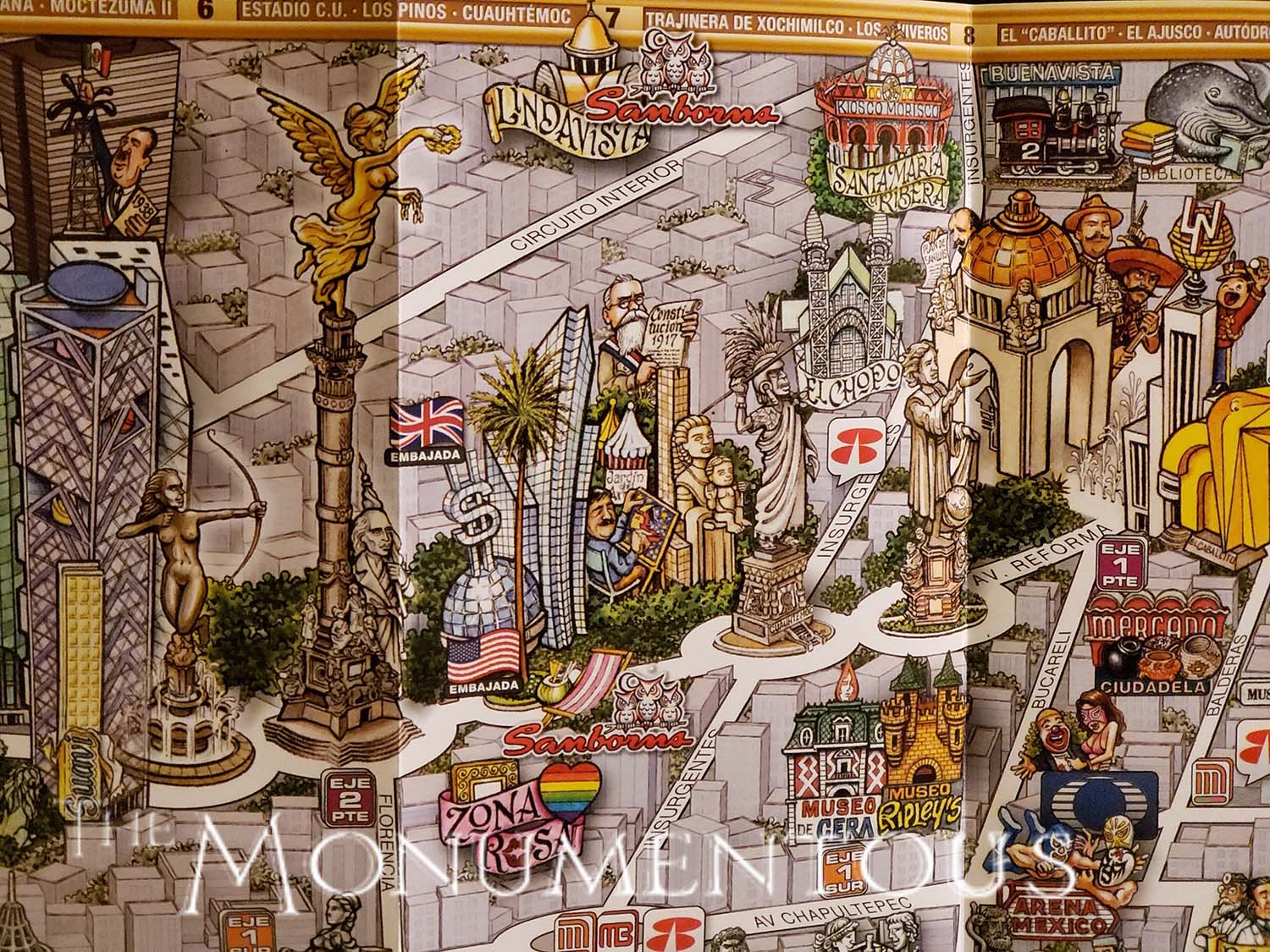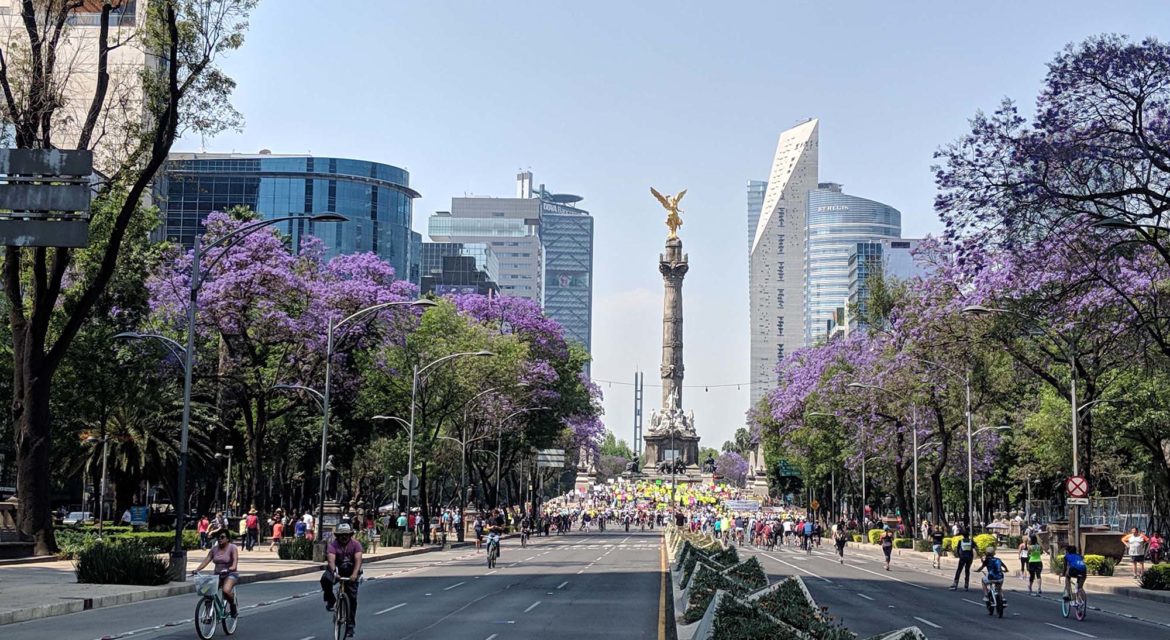 Like other famous streets across the world that range from the Champs-Élysées in Paris to the Auto Tour in Gettysburg, Paseo de la Reforma in Mexico City was designed with a very specific purpose in mind. Known locally as Reforma, the boulevard was intended to connect various parts of the city while simultaneously signifying a new era for it, but it ended up doing something far more significant.
Like other famous streets across the world that range from the Champs-Élysées in Paris to the Auto Tour in Gettysburg, Paseo de la Reforma in Mexico City was designed with a very specific purpose in mind. Known locally as Reforma, the boulevard was intended to connect various parts of the city while simultaneously signifying a new era for it, but it ended up doing something far more significant.
The way in which it has physically and figuratively connected Mexico City has become significant in numerous cultural and economic ways. Doing so has enabled Reforma to become a monument in and of itself that attracts audiences to experience the legacy it represent for Mexico City and the country as a whole.

Connecting Mexico City
The 1860s was a time of upheaval for Mexico City and the entire nation. Maximilian I had been crowned Emperor of Mexico and wanted to make his mark on the city. He moved forward with plans for a grand avenue that would link the city center with his imperial residence, Chapultepec Castle. Between 1864 and 1865 a section of the enormous road was completed but was reserved for the exclusive use of the imperial court. By 1867, Maximilian was executed to restore the Mexican Republic which also opened up the road to everyone.
In 1872 the road was renamed Paseo de la Reforma in honor of the reforms carried out under President Benito Juárez. Work continued on Reforma and was taken to a level under Porfirio Díaz, who seized power in 1876. He supported the aggrandizement of Paseo de la Reforma with statues representing Mexico’s heroes through its history, creating monuments that would remind everyone of the sacrifices that were made in the wars and conflicts that had come to define Mexico.
 Statues and artworks commemorating persons and events in Mexican history were placed in the traffic roundabouts over the next few decades, and the importance of doing so is something that has resonated into the current day. In 2003, the Mexican government started a renewal program for Reforma which included the maintenance of the gardens that already existed along Reforma along with the creation of new ones. Intensive cleaning and sweeping of streets and sidewalks also began as well as the creation of new features like dedicated tourist routes.
Statues and artworks commemorating persons and events in Mexican history were placed in the traffic roundabouts over the next few decades, and the importance of doing so is something that has resonated into the current day. In 2003, the Mexican government started a renewal program for Reforma which included the maintenance of the gardens that already existed along Reforma along with the creation of new ones. Intensive cleaning and sweeping of streets and sidewalks also began as well as the creation of new features like dedicated tourist routes.
These improvements have helped Paseo de la Reforma to become a main attraction of Mexico City and the most expensive section of the city to build on. Reforma has turned into the center of a real estate renaissance, a fact which is driven by the experiences that are enabled all across it.

A Collection of Monuments, Exhibitions and More
 A walk down Paseo de la Reforma exposes visitors to an avenue that is filled with tourist attractions, restaurants, hotels, office buildings, public art exhibitions, and new construction. This collection of experiences and activities is ultimately driven by the large and small monument that are located up and down Reforma.
A walk down Paseo de la Reforma exposes visitors to an avenue that is filled with tourist attractions, restaurants, hotels, office buildings, public art exhibitions, and new construction. This collection of experiences and activities is ultimately driven by the large and small monument that are located up and down Reforma.
Smaller statues line both sides of the boulevard and depict reformers that contributed to the Mexican Revolution as well as writers and journalists who influenced the political discourse of the early nation. These statues all have plaques and information about that person’s accomplishments. Well over 50 of these pieces are located up and down Reforma.
The most notable monument along Reforma is the Angel of Independence, which has become a symbol of the city and nation. Built in 1910 to commemorate the centennial of the beginning of Mexico’s War of Independence, it has since become a focal point for both celebrations and protests, underscoring why it has become one of the most recognizable landmarks in Mexico City and something that represents the very culture and traditions of the society. Like other similar victory columns, a statue of Nike, the Greek goddess of Victory, crowns it.
 The Monument to Cuauhtémoc is dedicated to the last Mexica ruler of Tenochtitlan, while the Diana the Huntress Fountain along with a monument dedicated to Christopher Columbus are the other notable pieces along Reforma. These monuments are interspersed with other pieces of art and temporary installations that detail more some of the more recent cultural and historical happenings in the Mexico City. A walk down Reforma exposes visitors to various eras and influences that have shaped the region to make a significant economic and cultural impact.
The Monument to Cuauhtémoc is dedicated to the last Mexica ruler of Tenochtitlan, while the Diana the Huntress Fountain along with a monument dedicated to Christopher Columbus are the other notable pieces along Reforma. These monuments are interspersed with other pieces of art and temporary installations that detail more some of the more recent cultural and historical happenings in the Mexico City. A walk down Reforma exposes visitors to various eras and influences that have shaped the region to make a significant economic and cultural impact.

Cultural Influence and Economic Opportunities
 Every Sunday, Reforma is transformed into a place for pedestrians, athletes and citizens. Zumba trainers get hundreds of people moving from two immense stages. Thousands of people bike and walk down the avenue in a display the signifies what it has come to represent for the entire city.
Every Sunday, Reforma is transformed into a place for pedestrians, athletes and citizens. Zumba trainers get hundreds of people moving from two immense stages. Thousands of people bike and walk down the avenue in a display the signifies what it has come to represent for the entire city.
These actives are part of what has contributed to the real estate boom that has redefined the entire area. The renewal project of 2003 enabled the area to become a main attraction of the city and the most expensive one to build on. Banks and businesses have moved out of the area, but that allowed restaurants and hotels to move in, with the St. Regis Hotel, Ritz-Carlton Hotel & Residences and a Park Hyatt Hotel & Residences opening up on Reforma, helping to usher in a whole new era for it.
Stores of all sorts line Reforma as well, which has created incredible economic opportunities for businesses that range from coffee shops to bars the theaters. Many of these businesses have adopted the “Reforma” identity in one way or another, helping them to establish themselves and appeal to the residents and visitors that are constantly going through the area.
 Part of the reason audiences keep coming out goes beyond what’s on Reforma and goes back to the original intention of the project. Paseo de la Reforma ties together various sections and identities of the city, as the Monumento a la Revolución (“Monument to the Revolution”) is located near Reforma, while the historic center of Mexico City and Zócalo are both within walking distance of the avenue. By directly tying these monuments to Reforma, residents and tourists can easily get a much more complete sense of the city.
Part of the reason audiences keep coming out goes beyond what’s on Reforma and goes back to the original intention of the project. Paseo de la Reforma ties together various sections and identities of the city, as the Monumento a la Revolución (“Monument to the Revolution”) is located near Reforma, while the historic center of Mexico City and Zócalo are both within walking distance of the avenue. By directly tying these monuments to Reforma, residents and tourists can easily get a much more complete sense of the city.
The impact of Reforma’s transformation into a destination is evident in terms of how it is positioned on various tours and in countless guides, many of which have the Angel of Independence predominantly featured. In becoming an icon for the city itself, Reforma has created a legacy which goes back to the original intention of the boulevard while becoming so much more.

More than an Avenue, Boulevard or Street
 There are notable streets and boulevards across the world, all featuring various pieces of history and cultural significance. Few have been able to transition into monuments in and of themselves like Paseo de la Reforma though, but that’s only partly because of the impressive landmarks, statues and other means of engaging the community that are located up and down the avenue.
There are notable streets and boulevards across the world, all featuring various pieces of history and cultural significance. Few have been able to transition into monuments in and of themselves like Paseo de la Reforma though, but that’s only partly because of the impressive landmarks, statues and other means of engaging the community that are located up and down the avenue.
What would otherwise simply be a street running through Mexico City has become so much more thanks to the efforts to celebrate the history of the area as well as the organization of community events like the weekly transformation of the avenue into one solely for pedestrians and bikers. The legacy it has enabled by doing so is one that continues to have a major impact on the culture and economy of Mexico City and the region as a whole.

